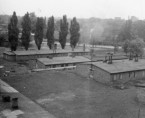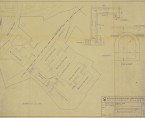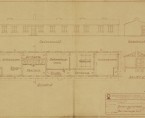Charlottegrube
A sub-camp at the Charlotte hard-coal mine in Rydułtowy, which belonged to the Hermann Göring Werke company. Prisoners were housed in two of the five camps for forced laborers and POWs already in existence there. The first 200 prisoners were presumably placed in one of these barracks in September 1944, and a month later there were already more than 600 prisoners there, mostly Jews from Hungary, Bohemia, and Slovakia. Some of the prisoners were quartered in another, smaller camp. Living conditions in both places were similar: the prisoners slept on three-tier bunk beds in brick buildings. Barbed-wire fences, not connected to the electricity mains, surrounded the camps. Although the prisoners were billeted in two separate places, they were subject to the same camp administration. The directors were, in turn, SS-Oberscharführer Alfred Tschiersky and SS-Hauptscharführer Kurt Kirschner. There were also 54 SS men in the garrison. Prisoners labored in two groups: one in the Leon II and Leon III mine shafts, and the other above ground, transporting and sorting coal, in the mine workshops, and building the Charlotte electric power station. Police, Wehrmacht soldiers, and uniformed members of the SA were employed as additional guards.
Working conditions were severe. As reflected in a management report, no less than half the prisoners lost their “ability to work” in the first four months of the sub-camp’s existence. Replacements were brought in by truck from Auschwitz, thanks to which the prisoner workforce reached 909 in this period. On the assumption that more than a hundred others worked in the kitchen, storage areas, or were in the infirmary, we can conclude that the prisoner population was then over one thousand. As indicated by the final report on January 17, 1945, there were only 833 in the camp, which would mean that another twenty percent of the prisoners lost their “ability to work” in the course of a month and were taken, after selection, to Birkenau. More than 50 prisoners died in the camp itself; several of them were suicides.
In January 1945, the plan was to evacuate the prisoners on foot to Gross-Rosen. After two days on the road, however, it turned out that Red Army units had cut off the escape route. The prisoners were therefore marched back to Rydułtowy, and then to Włodzisław Śląski, from where they went by train to the Mauthausen camp.


